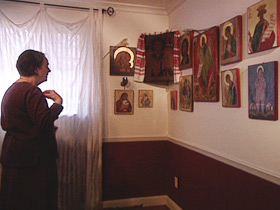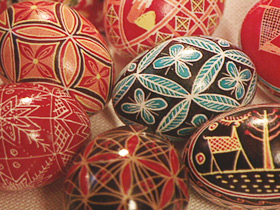In This Episode << SLIDE LEFT TO SEE ADDITIONAL SEGMENTS
Writing Icons
BOB ABERNETHY, anchor: Now, “writing” religious icons. In the Orthodox Christian tradition, icons are said to be written, not painted. The Orthodox consider making icons more a form of prayer than art, and they believe the iconographer’s hand is guided by God. We visited an iconographer, Maria Leontovitsch Manley, in her Bethesda, Maryland studio to learn more about the process, which can take days, often weeks, for just one icon. She also showed us how she decorates eggs for Orthodox Easter celebrations.

MARIA LEONTOVITSCH MANLEY (Iconographer): Before I start work, I like to say a prayer. And I usually go into a room where I have an icon corner.
It’s very important to be at peace with yourself and with the world around you. Writing an icon is a form of prayer. Each brushstroke is like a form of meditation. You have to have that inner peace. Otherwise, you can’t do it.
The process of writing an icon starts with the wooden board — the central area carved out, which is typical for Russian icons. And it’s called an ark, like the Ark of the Covenant.
The image of Christ is put into an ark. That wood is covered with cheesecloth. A gesso is prepared, which is made of rabbit-skin glue and chalk and water. And this is brushed onto the cheesecloth.
I incised the drawing into the gesso with an etching tool.
Before the gold can be applied, the area to be gilded has to be burnished and sanded, burnished and sanded several times until a perfectly smooth finish is achieved. If there are any imperfections, they will show through the gold. The gold is so thin. I use 24-carat gold leaf, which comes in a book of 24 sheets.
I breathe on it. Some people say it’s like breathing life into Adam. So we remember this when we breathe on the gold. After two layers of gold you can burnish it to a bright shine.
The paints are mixed with an egg emulsion. I use a yolk and mix it with water; take my powdered pigments, put a little bit in a mussel shell; add my egg-yolk mixture; use my finger to grind my pigments.
In the Russian tradition, we use a very liquid paint and a puddling technique.
Stylistically, there are some differences in the Greek and Russian schools of iconography. In the Greek Church, Christ is shown as the “Pantocrator” — the ruler of the universe. In the Orthodox Church, his image tends to be Christ the Merciful. I belong more to the Russian school myself.

“Christ is risen, Christ is risen.”
In the Eastern Church, the most important feast day is Easter. It’s called Feast of Feasts. In the West, we tend to have Christmas as the biggest holiday.
Eggs play an important part in the Russian tradition. People always give eggs in church on Easter. The egg symbolizes the resurrection and new life.
I make Ukrainian Easter eggs, and they’re called “pisanki.” It’s a very ancient art form.
I use a stylus, which I hold into the light of a candle. And when it gets hot, I hold it onto beeswax. Then I write on the egg, make my design.
These eggs, they’re raw inside. Eventually they dry out. And then you can hear the yolk rattling inside. People keep them for a long time.
I pull out the egg. It stayed in there about five minutes.
More and more, the icon is being recognized as a source of spirituality by people who are outside the Orthodox Church. And you see many icons now in churches of other denominations. I think it’s a very good thing.

